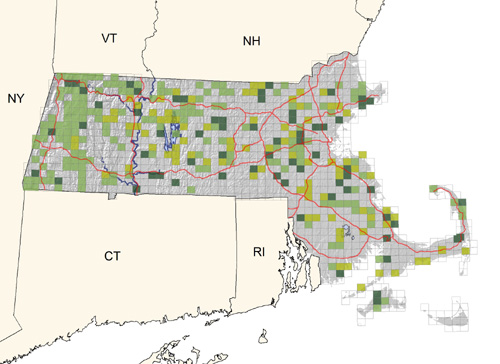Breeding Bird Atlases (BBA)
Find a Bird - BBA1
Breeding Bird Atlas 1 Species Accounts
Brown Creeper
Certhia americana
Egg Dates
April 24 to July 5
Number of Broods
one; may re-lay if first attempt fails.

The sole representative of its family in North America, the Brown Creeper is a small, inconspicuous bird, whose nesting activities are easily overlooked. Were it not for the song—a short, wiry, musical jumble of notes—its presence might go completely undetected. Fortunately, the male’s song period lasts from March through early July. Outside of the nesting season, it is equally obscure and gives a rather weak, sibilant seeet, similar to the call of the Golden-crowned Kinglet but longer, monosyllabic, and unaccented.
Prior to 1955, the Brown Creeper was largely restricted as a nester to the hill country of western and north-central Massachusetts; it occurs sporadically and is sometimes common locally eastward to the coast. Since 1960, the Brown Creeper seems to have increased markedly and expanded its regular nesting range. Nesting is now widespread and common throughout most of the state except in the northeast and southeast, where it remains only locally common, and in Nantucket County, where, lacking adequate forest, it is absent entirely as a nester.
The general maturing of forests throughout the state has benefited the Brown Creeper, which favors mature, mixed, swampy forest, including Atlantic White Cedar swamps, especially when there is an interspersion of dead trees with loose hanging bark. Following the return of the Beaver in the 1950s, a virtual population boom had occurred by the mid-1960s as the species opportunistically exploited the growing system of Beaver flowages and swamps and their attendant dead timber. Flourishing Brown Creeper populations exist in forests interlaced with Beaver impoundments, and these high populations have quite likely fueled some of the eastward range expansion evident in the last 20 years.
Creepers defend nesting territories of unknown size. Courting males sing and perform rapid, twisting flights. Nest building is at its peak in late April and early May but has been observed here as early as April 12 (BOEM). Nests are crescent shaped and built of mosses, twigs, dead leaves, and shredded bark, and lined with feathers and hair. They are almost invariably built 5 to 15 feet above the ground in standing or fallen dead trees beneath strips of bark that have become partially detached from the trunk and are curved inward. These nests, like the birds themselves, are extremely cryptic. Rotted-out cavities or old woodpecker holes are also reportedly used, although much less frequently. The female does most of the actual nest construction, although the male does fetch materials. While creepers are usually associated with mature, swampy forest, they will adapt to other sites, as evidenced by a nest in South Orleans 10 feet high in a Pitch Pine (CNR) and a nest in Charlton that was located 5 feet high behind the bark of a dead tree situated inside an old foundation in the woods and close to a driveway and several other buildings (Meservey).
Clutches of four to eight (average five to six) eggs are laid. Incubation by the female commences upon completion of the clutch and lasts 14 to 15 days. Young are altricial and fledge in approximately 14 days. Both sexes attend young at the nest and for a short period after fledging. Nestlings have been recorded in Massachusetts from May 8 to July 31 (TC, BOEM, Meservey). Fledging at one nest occurred on June 4 (ACB), and at the South Orleans nest at least five young fledged about July 17 (CNR). Adults accompanied by two to four young have been observed from May 24 to July 1 (TC, BOEM). While two broods are sometimes reared, it appears that most pairs have a single brood and that late nesting dates represent renesting efforts. The adults molt in August.
The seasonal movements of Brown Creepers are best characterized as mysterious. There is evidently some withdrawal from the highest and most northerly portions of the range in autumn, and birds show up ubiquitously with the vanguard of southbound passerines in early September. However, it is not clear whether Massachusetts birds actually migrate because Brown Creepers are present year-round, and there is no way to distinguish local birds from transients. While their movements seem to be at least partially migratory, they might be more accurately described as nomadic. In winter, they roam about the forests with troops of chickadees and nuthatches.
Whether there be subzero cold or summer heat, these birds just seem to carry on their mysterious lives, business as usual, working the trees in what has been described as their “myopic, preoccupied manner.”
Map Legend and Data Summary
Atlas 1 data collected from 1975-1979


Note: uncommon in coniferous and moist deciduous forests
Bradford G. Blodget



